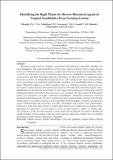| dc.description.abstract | Biocontrol agents such as predators, parasitoids and pathogens potentially regulate crop
pests populations. The agents feed directly on the pests, oviposit in the pest body or cause disease
in the pest. While biocontrol has become a commercial enterprise in temperate horticulture, there
is much less information on the biocontrol agents present in smallholder agricultural systems
in the tropics and little knowledge about the importance of plant diversity in supporting their
biocontrol activities. A standardized botanical survey walk combined with observations of plant insect interactions was conducted on field margin vegetation of 24 smallholder fields of common
beans (Phaseolus vulgaris L.) in three elevation zones of a tropical ecosystem. Sweep nets were
also used to capture the biocontrol agents and stored in 70% ethanol for detailed taxonomy where
identification in the field was not possible. A wide range of biocontrol agents interacting with the
field margin plants, particularly flowering forbs were revealed. The most preferred field margin
plants were Ageratum conyzoides, Commelina benghalensis, Pennisetum purpureum, Panicum
maximum and Tripsacum sp. The most common biocontrol agents found to interact with the field
margin plants were spiders (Araneae), long-legged flies (Dolichopodidae), predatory and parasitic
wasps (Ichneumonids and braconids), hoverflies (Syrphidae) and assassin bugs (Reduviidae).
Preferences of the biocontrol agents to certain plant species were similar across all three zones,
indicating the importance of such plants in terms of food resources, shelter or nesting sites.
The preference of the biocontrol agents to some plant species indicates the need to identify the
specific benefits of these species to the biocontrol agents to determine whether non-crop habitat
manipulation might enhance natural pest regulation.Biocontrol agents such as predators, parasitoids and pathogens potentially regulate crop
pests populations. The agents feed directly on the pests, oviposit in the pest body or cause disease
in the pest. While biocontrol has become a commercial enterprise in temperate horticulture, there
is much less information on the biocontrol agents present in smallholder agricultural systems
in the tropics and little knowledge about the importance of plant diversity in supporting their
biocontrol activities. A standardized botanical survey walk combined with observations of plant insect interactions was conducted on field margin vegetation of 24 smallholder fields of common
beans (Phaseolus vulgaris L.) in three elevation zones of a tropical ecosystem. Sweep nets were
also used to capture the biocontrol agents and stored in 70% ethanol for detailed taxonomy where
identification in the field was not possible. A wide range of biocontrol agents interacting with the
field margin plants, particularly flowering forbs were revealed. The most preferred field margin
plants were Ageratum conyzoides, Commelina benghalensis, Pennisetum purpureum, Panicum
maximum and Tripsacum sp. The most common biocontrol agents found to interact with the field
margin plants were spiders (Araneae), long-legged flies (Dolichopodidae), predatory and parasitic
wasps (Ichneumonids and braconids), hoverflies (Syrphidae) and assassin bugs (Reduviidae).
Preferences of the biocontrol agents to certain plant species were similar across all three zones,
indicating the importance of such plants in terms of food resources, shelter or nesting sites.
The preference of the biocontrol agents to some plant species indicates the need to identify the
specific benefits of these species to the biocontrol agents to determine whether non-crop habitat
manipulation might enhance natural pest regulation. | en_US |

